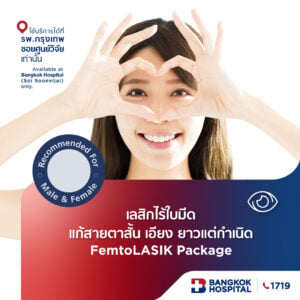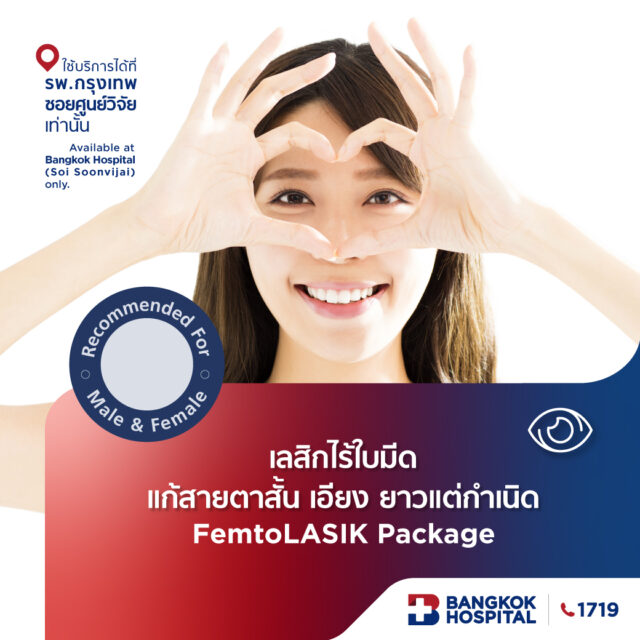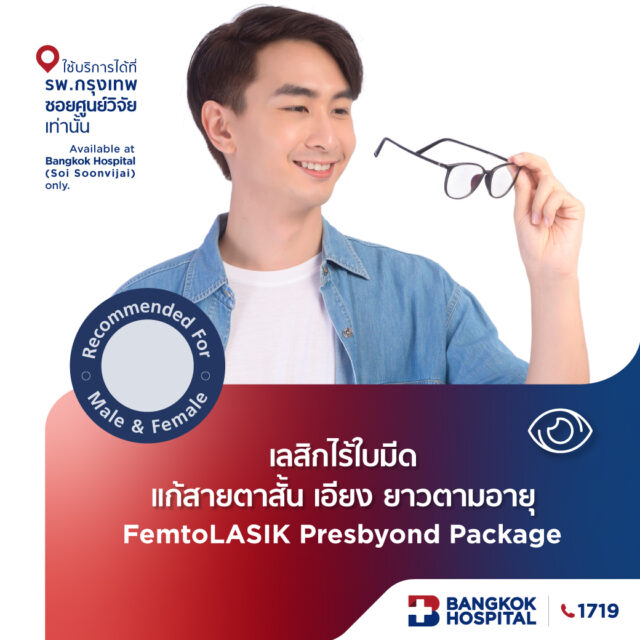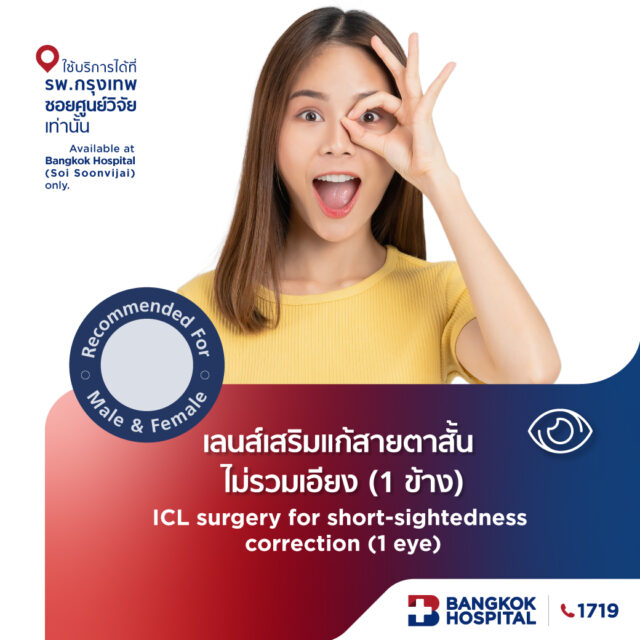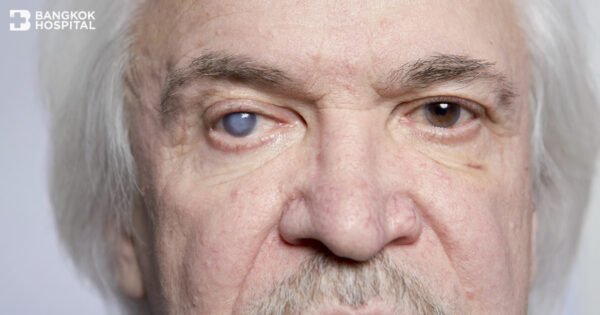A cataract is a dense, cloudy area that forms in the lens of the eye. Although it is age-related condition that gradually develops in the elderly over time, a cataract can be also found in people aged over 40. Contributing factors to cataracts in younger age group usually involve prolonged use of corticosteroid medications, previous eye injury or inflammation and excessive exposure to sunlight. Warning signs and symptoms are clouded, blurred or dim vision and increasing difficulty with vision at night. If left untreated, these symptoms progressively continue as cataracts grow larger, resulting in continual loss of vision. It eventually leads to legal blindness or even total blindness. Being aware of abnormal signs substantially helps to prevent cataracts and reduce disease severity. Having regular eye examinations can significantly detect cataracts and other eye problems at their earliest stages before diseases progress and complications develop.
Get to know cataracts
A cataract is a clouding of the normally clear lens of the eye. The lens focuses light that passes into the eye, producing clear, sharp images on the retina. Cataracts begin when proteins in the eye form clumps that prevent the lens from sending clear images to the retina. Due to increasing age, the lenses in the eyes become thicker with less flexibility and less transparency. Tissues within the lens break down and clump together, forming clouding small areas within the lens. As cataracts continue to develop, the clouding parts become denser and involve bigger areas of the lens. Cataracts scatter and block the light passing through the lens, preventing a sharply defined image from reaching the retina. As a result, the vision becomes blurred. Cataracts do not spread from one eye to another. However, they might develop in both eyes with different severity. If left untreated, progressive cataracts can eventually cause permanent vision loss.
Risk factors of cataracts
Factors that increase risk of cataracts include:
- Increasing age: Aging is the major cause of lens degeneration. Cataracts often appear first when persons are in his or her 40s or 50s.
- Diabetes: Cataract is one of the major causes of visual impairment in diabetic patients. Since uncontrolled sugar level aggravates the clouding lenses, diabetic patients are reported to be more likely to develop cataract, compared to non-diabetic people in similar age group.
- Prolonged use of corticosteroid medications: Corticosteroid drugs typically induce cataract formation in the cortex of the posterior region of the lens, called posterior subcapsular cataract.
- Previous eye injury or inflammation: Eye injuries or blunt trauma can cause cataracts. Damages to the lens can result in either an immediate cataract or a delayed cataract.
- Smoking: Smoking is significantly associated with cataract formation. Mounting evidence has revealed that smoking contributes to cataracts by accumulating certain heavy metals and altering the cells of the lens through oxidation process.
- Excessive exposure to sunlight without proper eye protection: The study firms up a strong linkage between the sun’s damaging rays and oxidative stress that damages the lenses.
- Lens opacity which is present at birth due to infections (congenital cataracts)
Signs and symptoms
- Clouded, blurred or dim vision which gradually develops
- Increasing difficulty with vision like looking through a frosty or fogged-up window
- Double vision in a single eye
- Seeing halos around lights and sensitivity to light or glare
- Fading or yellowing of colors
- Frequent changes in eyeglass or contact lens prescription
Treatment of cataracts
When the prescription glasses cannot clear blurred vision, the only effective treatment option for cataracts is surgery. Cataract surgery involves the removal of the clouded lens and replacing it with a clear artificial lens, called an intraocular lens. Phacoemulsification is a modern cataract surgery approach in which the eye’s internal lens is emulsified with an ultrasonic handpiece and the cataracts are aspirated from the eye. Through a small incision sized 3-5 mm. in diameter, foldable intraocular lens can be then inserted and placed to replace the damaged lens. On an outpatient basis, this procedure takes only 15-30 minutes. Due to advancements in minimally invasive cataract surgery, it results in less postoperative complications and faster recovery after surgery, allowing patients to quickly return to their daily lives and activities. Nevertheless, for some patients, other eye problems e.g. uveitis, glaucoma and diabetic eye problems (diabetic retinopathy) prohibit the use of an artificial lens. In these situations, after the cataract is removed, vision may be further corrected with eyeglasses or contact lenses. Treatments conducted by the specialists for individual patients are planned based primarily upon symptoms, disease severity and each patient’s conditions.
Instructions after surgery
To prevent infection after cataract surgery, it is essentially vital to strictly comply with the instructions recommended by an ophthalmologist. Advices for post cataract surgery include:
- Wear protective eye-shields as directed
- Follow the prescriptions regarding any antibiotic and anti-inflammatory eye drops
- Do not expose to the strong wind and sunlight
- Stay away from dusty areas
- Keep the eyes away from water
- Do not rub the affected eye.
- Do not do any strenuous activities for a few weeks. Avoid rigorous exercise and heavy lifting.
Schedules for follow up should be also strictly followed. If any abnormal sign or symptom e.g. eye pain, red eyes, seeing moving lights or black spots and blurred vision exhibits after surgery, immediate medical attention must be sought.
Prevention of cataracts
Although no studies have proved how to prevent cataracts or slow the progression of cataracts, these recommendations may be helpful to reduce the risk of cataracts:
- Wearing sunglasses and avoid exposure to sunlight
- Controlling blood sugar level in the desired range for diabetic patients
- Smoke cessation, if smoke
- Eating healthy diets
- Regular exercise
- Using corticosteroid eye-drops without prescription from the ophthalmologist must be avoided
- Having regular eye examinations when aged over 40. Eye examinations can help detect cataracts and other eye problems at their earliest stages.


